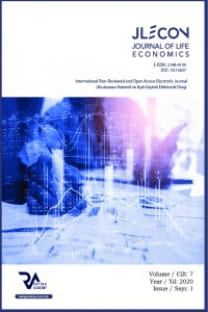THE CHANGE IN THE MANAGEMENT STRUCTURE OF MEDIA INSTITUTIONS IN THE FOURTH INDUSTRIAL REVOLUTION (INDUSTRY 4.0) PROCESS
The Fourth Industrial Revolution, Industry 4.0, Media Institutions
THE CHANGE IN THE MANAGEMENT STRUCTURE OF MEDIA INSTITUTIONS IN THE FOURTH INDUSTRIAL REVOLUTION (INDUSTRY 4.0) PROCESS
___
- ALÇIN, S. (2019). “Üretim İçin Yeni Bir İzlek: Sanayi 4.0”. Journal of Life Academics, 3(2), s. 19-30 https://dergipark.org.tr/download/article-file/305119 Date of Access: 07.07.2019
- ALTINTAŞ YILMAZ, E. (2018). “Dijital Dönüşüm Uygulamalarının Kurumların Marka Değeri Üzerindeki Etkisi”. Ege Üniversitesi İletişim Fakültesi Medya ve İletişim Araştırmaları Hakemli e-Dergisi, (e-Journal of Ege University Faculty of Communication Media and Communication Research) 2, s. 1-18. https://dergipark.org.tr/download/article-file/464395 Date of Access: 07.07.2019
- ARSLAN, K.; KIRBAŞ, İ. (2016). “Nesnelerin İnterneti Uygulamaları İçin Algılayıcı/Eyleyici Kablosuz Düğüm İlkörneği Geliştirme”. Mehmet Akif Ersoy Üniversitesi Fen Bilimleri Enstitüsü Dergisi, (International Journal of Mehmet Akif Ersoy University Institute of Natural Sciences) Özel Sayı 1, s. 35-43. http://dergipark.ulakbim.gov.tr/makufebed/article/view/5000195368/5000170277 Date of Access: 01.06.2019
- ARTZ, L. (2016). “Transnational Media Corporations and the Global Division of Cultural Labor and Consumption”. Revue Française des Sciences de l'Information et de la Communication, 17(2), s 25-38 https://www.researchgate.net/publication/315477765_Transnational_Media_Corporations_and_the_Global_Division_of_Cultural_Labor_and_Consumption Date of Access: 07.07.2019
- BARTODZİEJ, C. J. (2017). “The Concept Industry4.0”. In: The Concept Industry 4.0. Springer Gabler, Wiesbaden, 27-50.
- BAYTAR, O. (2011). “Küreselleşme Dinamiklerinin Medya Sektörüne Etkileri”. Hak İş Uluslararası Emek ve Toplum Dergisi, (Hak İş International Journal of Labor and Society) 3, s. 234-261. http://www.ktu.edu.tr/dosyalar/iletisimarastirmalari_1fcea.pdf Date of Access: 01.07.2019
- BBC, (2018). “Dünyanın İlk 'Yapay Zeka Spikeri' Ekrana Çıktı”. https://www.bbc.com/turkce/haberler-46138326 Date of Access: 15.04.2019
- CHEN, JWM.; LI, F. (2012). “Machine-to-Machine Communications: Architectures, Standards, and Applications”. KSII Transactions on Internet and Information Systems, 6(2). https://www.researchgate.net/publication/264846553_Machine-to-Machine_Communications_Architectures_Standards_and_Applications Date of Access: 01.06.2019
- EP. (2015). “Briefing: Industry 4 – Digitalisation for productivity and growth”, European Parliament, Luxembourg, 10s.
- Endüstri40.com. “Siber Fiziksel Sistemler”. https://www.endustri40.com/siber-fiziksel-sistemler/ Date of Access: 08.07.2019
- GEİSSBAUER, R.; VEDSO, J.; SCHRAUF, S. (2016). “A Strategist’s Guide to Industry 4.0”, http://www.strategy-business.com/article/A-Strategists-Guide-to-Industry-4.0?gko=7c4cf , Date of Access: 28.11.2016
- HARRIS, J. M., (2000). “Sürdürülebilir Kalkınmanın Temel Prensipleri”. Transl. Emine Özete http://www.sdergi.hacettepe.edu.tr/makaleler/EmineOzmet2eviri.pdf Date of Access: 01.06.2019
- HERMANN, M., PENTEK, T., OTTO, B. (2015). “Design Principles for Industrie 4.0 Scenarios: A Literature Review”. Working Paper, No. 01 / 2015, Technische Universität Dortmund.
- HOLLIFIELD, C. A.; BECKER, Lee, B. ve VLAD, T. (2006). “The Effects of Political, Economic and Organizational Factors on the Performance of Broadcast Media in Developing Countries”, paper presented to the Political Communication Division of the International Association for Media and Communication Conference, Kahire, Mısır.
- IGARASHİ, Y., UENO, M., FUJİSAKİ, T. (2012). “Proposed Node and Network Models for an M2M Internet”. World Telecommunications Congress (WTC), Mart, s. 1–6.
- MMC, (2017). “Trumpf Building Technology Center Near Chicago”. Modern Machine Shop http://www.mmsonline.com/news/trumpf-building-technology-center-near-chicago , Date of Access: 22.01.2017
- SputnikNews, (2019). “Çin, Dünyanın Yapay Zekalı İlk Kadın Haber Sunucusunu Tanıttı”. https://tr.sputniknews.com/bilim/201902211037790208-cin-dunyanin-yapay-zekali-kadin-haber-sunucusu/ Date of Access: 10.07.2019
- UZKURT, C. (2010). “İnovasyon Yönetimi: İnovasyon Nedir, Nasıl Yapılır ve Nasıl Pazarlanır?” http://www.aso.org.tr/b2b/asobilgi/sayilar/4dosyatemmuzagustos2010.pdf Date of Access: 01.06.2019
- WEF, (2018). “Global Competitiveness Report 2018”. World Economic Forum. http://www3.weforum.org/docs/GCR2018/05FullReport/TheGlobalCompetitivenessReport2018.pdf Date of Access: 02.07.2019
- WEF, (2017). “Global Competitiveness Report 2017”. World Economic Forum. http://www3.weforum.org/docs/GCR2017-2018/05FullReport/TheGlobalCompetitivenessReport2017%E2%80%932018.pdf Date of Access: 02.07.2019
- Yayın Aralığı: Yılda 4 Sayı
- Başlangıç: 2014
- Yayıncı: Rating Academy
KÜRESELLEŞME SÜRECİNDE MARKALAŞMA VE ÇOK ULUSLU ŞİRKET MARKALARI & MARKALARIN KÜRESEL ETKİNLİĞİ
VİTRİN ŞEHİR: SİLOPİ ÖRNEĞİNDE GİZİLGÜÇ İKTİSADİ KAZANIMLAR
BIST 100 DE YER ALAN ANA METAL SANAYİ FİRMALARININ VERİ ZARFLAMA ANALİZİ İLE PERFORMANS ÖLÇÜMÜ
KÜRESELLEŞME SÜRECİNDE MARKALAŞMA VE ÇOK ULUSLU ŞİRKET MARKALARI & MARKALARIN KÜRESEL ETKİNLİĞİ
FISCAL DEFICITS AND INTEREST RATES IN BRICS ECONOMIES: TESTING THE KEYNESIAN-RICARDIAN OPPOSITION
Edward Kagiso MOLEFE, Gisele MAH
Khalil ISRAFILZADE, Najaf BABAYEV
Filiz Tufan EMİNİ, Çağlar Eren AYAZ
